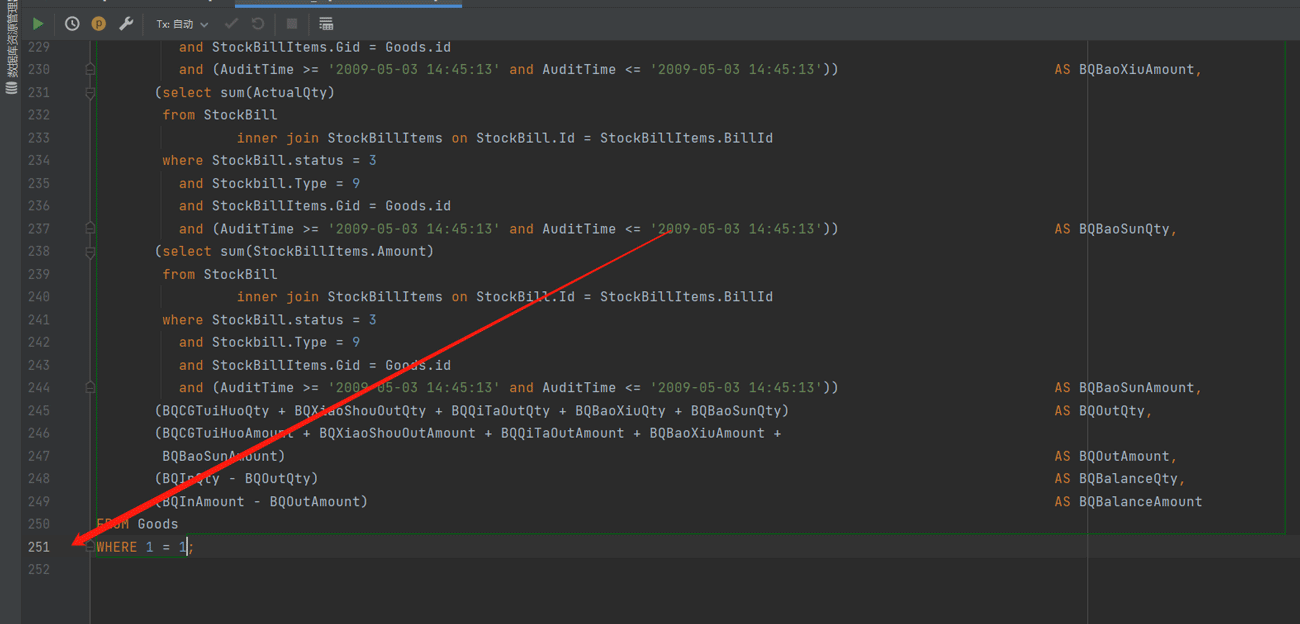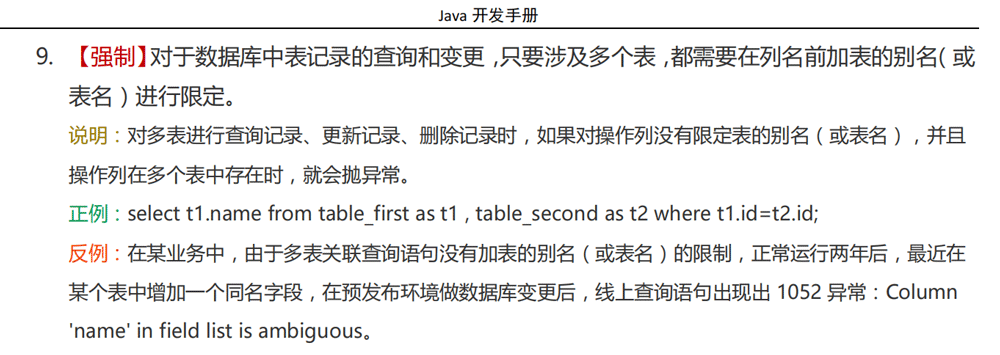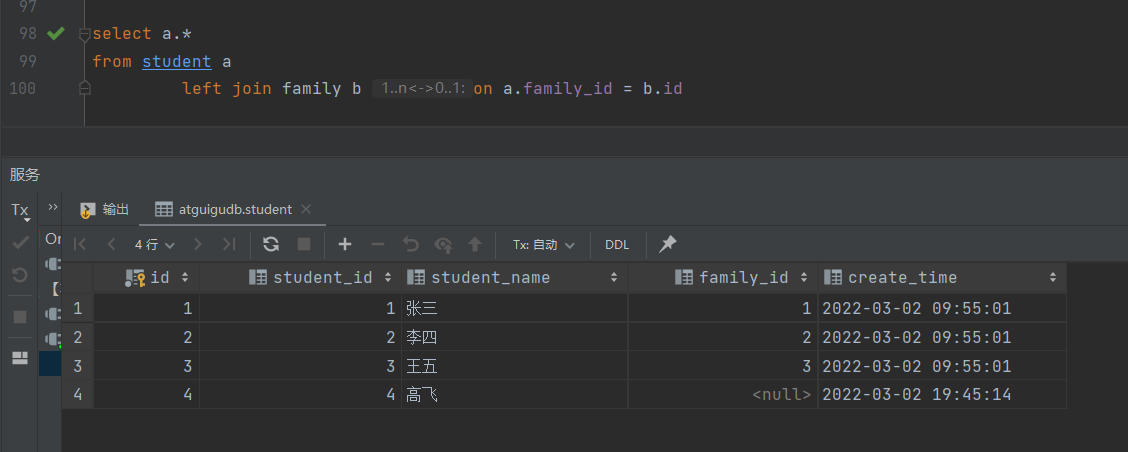MySQL多表查询
返回主页深海云帆 人气:01. 前言
在SQL开发当中,多表联查是绝对绕不开的一种技能。同样的查询结果不同的写法其运行效率也是千差万别。
在实际开发当中,我见过(好像还写过~)不少又长又臭的查询SQL,数据量一上来查个十几分钟那是家常便饭。
因此,深入理解SQL的多表查询机制,少写一些慢查询,应该可以少挨点骂。

2. 等值连接和非等值连接
2.1 等值连接
等值连接是在多表查询中最基础,也最简单的一种,其值为所有满足条件的笛卡尔积。
在from后面,哪个表写在前面结果中哪个表的值就先出现,
如下:
select * from student, family where student.family_id = family.id;
等值连接查询结果:

阿里在最新发布的Java开发手册中强制要求,只要涉及多个表,必须在列名前加表的别名(或表名)进行限定

2.2 非等值连接
非等值连接是通过a表中的值在b表中的某一个范围来进行的,能够很好的满足预设定好的分段统计需求。
非等值连接有两种写法,使用between...and...或大于号小于号
第一种写法:使用between...and...
select a.discipline_name, a.score, b.grade_tag from achievement a, achievement_grade b where a.score between b.lowest_score and b.highest_score;
第二种写法:使用>=或<=
select a.discipline_name, a.score, b.grade_tag from achievement a, achievement_grade b where a.score >= b.lowest_score and a.score <= b.highest_score;
非等值连接查询结果:

3. 自连接和非自连接
3.1 自连接
自连接,顾名思义就是同一张表自己跟自己连接,为了区分需要给表取不同的别名。如一张成绩表,需要查询所有分数比“语文”高的数据:
分数表:

若不使用自连接,需要先通过查询语文的分数,然后再查询大于这个分数的数据。
具体可以按如下步骤进行查询:
-- 先查询语文的分数 select score from achievement where discipline_name = '语文'; -- 再查询分数比语文分数更高的数据 select * from achievement where score > 76;
而使用自连接,则可以在一条sq语句里完成查询:
select a.* from achievement a, achievement b where b.discipline_name = '语文' and a.score > b.score;
自连接查询结果:

3.2 非自连接
除自连接外,其他的都叫非自连接~~~
4. 内连接和外连接
内连接和外连接的区分本质上是另一种分类方法,如内连接就是等值连接。
- 内连接:合并具有同一列的两个或两个以上的表的行, 结果集中不包含一个表与另一个表不匹配的行
- 外连接:两个表在连接过程中除了返回满足连接条件的行以外还返回左(或右)表中不满足条件的
行 ,这种连接称为左(或右) 外连接。没有匹配的行时, 结果表中相应的列为空(NULL)。
- 左外连接:连接条件中左边的表也称为主表 ,右边的表称为从表 。
- 右外连接:连接条件中右边的表也称为主表 ,左边的表称为从表 。
- 全外连接
4.1 测试数据
测试用学生表student和家庭表family数据如下:
学生表数据:

家庭表数据:

4.2 左外连接
-- 查出student中的所有数据,不满足的显示为null -- 这里student在前面 select a.* from student a left join family b on a.family_id = b.id
左外连接查询结果:

4.3 右外连接
-- 查出student中的所有数据,不满足的显示为null -- 这里student在后面 select a.* from family b right join student a on b.id = a.family_id;
右外连接查询结果:

4.4 全外连接
很遗憾,MySQL不支持全外连接。
附录:测试数据SQL脚本
-- auto-generated definition create table student ( id int auto_increment primary key, student_id int null comment '学号', student_name varchar(40) null comment '姓名', family_id int null comment '家庭ID', create_time datetime default CURRENT_TIMESTAMP null comment '创建时间' ) comment '学生表'; create table family ( id int auto_increment primary key, family_name varchar(40) null comment '家庭名称', family_address varchar(40) null comment '家庭地址', create_time datetime default CURRENT_TIMESTAMP null comment '创建时间' ) comment '家庭表'; create table achievement ( id int auto_increment primary key, score int null comment '分数', discipline_name varchar(40) null comment '学科名称', student_id int null comment '学号' ) comment '成绩表'; create table achievement_grade ( id int auto_increment primary key, grade_tag varchar(10) null comment '档次', lowest_score int null comment '最低分', highest_score int null comment '最高分', create_time datetime default CURRENT_TIMESTAMP null comment '创建时间' ) comment '分数档次表'; INSERT INTO achievement_grade (id, grade_tag, lowest_score, highest_score, create_time) VALUES (1, '不及格', 0, 60, '2022-03-02 11:44:01'); INSERT INTO achievement_grade (id, grade_tag, lowest_score, highest_score, create_time) VALUES (2, '良好', 60, 80, '2022-03-02 11:44:01'); INSERT INTO achievement_grade (id, grade_tag, lowest_score, highest_score, create_time) VALUES (3, '优秀', 80, 100, '2022-03-02 11:44:01'); INSERT INTO student (id, student_id, student_name, family_id, create_time) VALUES (1, 1, '张三', 1, '2022-03-02 09:55:01'); INSERT INTO student (id, student_id, student_name, family_id, create_time) VALUES (2, 2, '李四', 2, '2022-03-02 09:55:01'); INSERT INTO student (id, student_id, student_name, family_id, create_time) VALUES (3, 3, '王五', 3, '2022-03-02 09:55:01'); INSERT INTO student (id, student_id, student_name, family_id, create_time) VALUES (4, 4, '高飞', null, '2022-03-02 19:45:14'); INSERT INTO family (id, family_name, family_address, create_time) VALUES (1, '张三家', '北京', '2022-03-02 09:54:13'); INSERT INTO family (id, family_name, family_address, create_time) VALUES (2, '李四家', '上海', '2022-03-02 09:54:13'); INSERT INTO family (id, family_name, family_address, create_time) VALUES (3, '王五家', '西伯利亚', '2022-03-02 09:54:13'); INSERT INTO achievement (id, score, discipline_name, student_id) VALUES (1, 76, '语文', 1); INSERT INTO achievement (id, score, discipline_name, student_id) VALUES (2, 80, '数学', 1); INSERT INTO achievement (id, score, discipline_name, student_id) VALUES (3, 65, '英语', 1); INSERT INTO achievement (id, score, discipline_name, student_id) VALUES (4, 98, '地理', 1); INSERT INTO achievement (id, score, discipline_name, student_id) VALUES (5, 77, '历史', 1); INSERT INTO achievement (id, score, discipline_name, student_id) VALUES (6, 69, '生物', 1);
加载全部内容